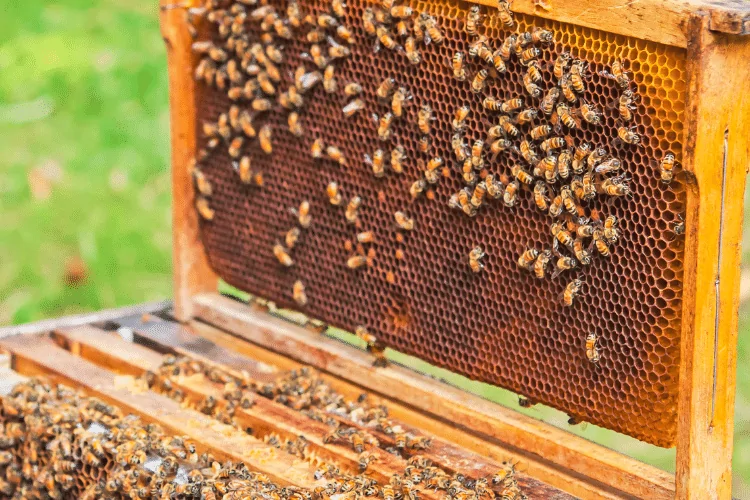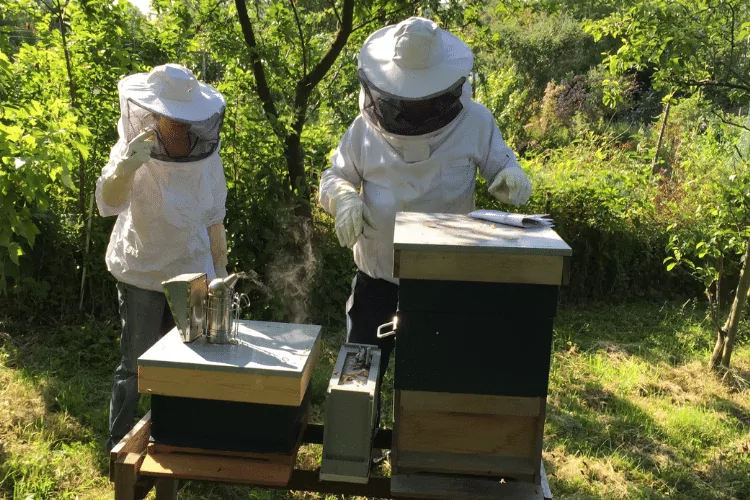Nourishing your bees and providing them with food is essential for their survival and growth. Luckily, there are plenty of options out there when it comes to feeding bees.
However, two of these options are fairly more common than others, which are frame feeders and top feeders, so which one of them should you go for?
In this guide, we’ll walk you through both types of feeders, so you can pick the one that suits your needs the best. Let’s jump right in!
What Is a Frame Feeder for Bees?
Frame feeders, also known as “Division feeders” or “Division board feeders” are a type of feeders that are designed to fit directly inside a standard Langstroth hive by replacing one or more frames in the brood chamber.
They usually come in standardized sizes of the hives they’re designed to fit in, ranging from 2 to 3 inches wide. This allows them to have different volumes of syrup to feed the bees.
The exact capacity of frame feeders varies from one manufacturer to another. Yet, a typical 8-frame feeder usually holds around 3 gallons of syrup while 10-frame feeders carry a little more than 4 gallons.
Frame feeders are made from various materials. For example, old frame feeders were commonly made from wax-dipped tin as well as wood.
Currently, most frame feeders are available in molded plastic, which is relatively lightweight and easy to remove.
Advantages of Frame Feeders
One of the best things about frame feeders is that they’re designed to hold a decent amount of syrup, especially in larger hives. They also keep the syrup safely contained and away from the elements and parasites.
This means less management time, especially if you live relatively far from where you keep the bees.

They also allow for rapid consumption of the syrup, which allows bees to quickly establish honey reserves for the winter.
Another major advantage of frame feeders is that they’re relatively affordable, especially when compared to top feeders. This makes them perfect for someone who wants to start beekeeping but is worried about the costs.
Disadvantages of Frame Feeders
Although frame feeders are an all-around great investment for most beekeepers, they still have several issues.
For starters, they take up space inside the hive. This means that you’ll need to expose the hive every time you need to refill it.
This disturbs the bees and doesn’t work well in winter because it massively reduces the hive’s temperature, resulting in a slowed activity.
Additionally, although new designs use floats and rough edges to protect the bees from drowning, you’re still going to lose large quantities of bees because of frame feeders.
How to Make a Frame Feeder for Bees
Ideally, buying a ready-made frame feeder for your bees is more cost-effective than building them yourself.
This is because commercial frame feeders are highly affordable while being well-built, so they save you a lot of effort, time, and money. However, if you insist on building one, here’s a simple way to do it.
- First, you’ll need to buy some styrofoam blocks from a hardware store and cut them to fit the size of your hive (relative to other frames).
Make sure that the blocks you’re using are made from a bee-safe material. You can also use a hot wire saw to make clean cuts on styrofoam. A good tip here is to mark your outline so that it’s wider on top (so that it rests on the frame holder).
- Now that you have a frame-shaped block, you’ll need to carve it so that it’s hollow to contain the syrup. To do that, you’ll use a chisel to carefully remove the insides of the block without damaging it on the outside.
- Wrap the outside of the frame with some aluminum foil to protect it from moisture inside the hive.
- Next, you’ll need to drill two circular holes in the center of a thin wooden board, then attach it to the top of the carved side using screws. This will be the top of the frame that sits on top.
- Roll two pieces of screen mesh into cylinders and fit them inside the drilled holes. These will act as planks to protect the bees from drowning while feeding on syrup.
What Is a Top Feeder for Bees?
A top feeder is a collective term that describes a wide variety of beehive feeder designs that all have one thing in common: they fit on top of the upper box.
The feeder is made from various materials, including wood, metal, and molded plastic. The containers are usually inverted over the entry hole in the inner hive cover. However, some models just sit on top or are enclosed inside an empty super.
The basic design of most top feeders features a shallow box with a plastic container for the syrup.
The setup is usually fitted over the hole of the inner cover and has hardware cloth fitted to allow the bees to reach the syrup without drowning. Like frame feeders, top feeders also come in a wide range of sizes to fit standard 8 and 10-frame Langstroth hives.
Advantages of Top Feeders
There are several reasons why top feeders are a good choice for you. One of the main advantages of top feeders is the high capacity they usually offer. This means that you only need to refill the reservoir with syrup once every few days/weeks.
Additionally, the plenty of access surface allows many bees to reach the feeding area and consume syrup simultaneously.
This is particularly necessary during the fall months because the feeding window is quite limited, so waiting for other bees to finish eating might affect the hive’s productivity rate and winter survival significantly.

Another reason to like top feeders is that the syrup sits protected inside the box. This means that the syrup is not only protected from the sun but also from robbers and other pests.
Additionally, unlike frame feeders, you don’t need to expose the whole hive in order to refill the feeder. This puts minimum stress on the bees, which is great for their productivity.
Disadvantages of Top Feeders
Despite all their merits, top feeders are not entirely perfect and still have some downsides and potential drawbacks.
For example, while having a large capacity is a major advantage if you live far from the apiary, it’s hardly essential if you have the hive in your backyard that you can access every day.
Another problem with using top feeders is that similar to frame feeders, you still can monitor the level of syrup left without inspection. However, a top feeder filled with syrup can be quite heavy, which can be quite problematic if you work alone.
You should also know that top feeders are usually among the most expensive options when it comes to bee nourishment.
However, they’re still a relatively cost-effective solution, as they quickly save you a lot of time and trips to regularly refill the feeder. It also saves you the productivity loss caused by drowning, especially when compared with frame feeders.
How to Make a Top Feeder for Bees
Similar to frame feeders, it’s usually better to go for commercial top feeders than build them yourself. This increases their efficiency and reduces the risks of bees drowning because of the syrup.
However, if you have the DIY skills and tools necessary, you can still build a simple top feeder for your beehive. Here’s how to do it:
- First, you’ll need a 1/2-inch plywood sheeting to act as the base of your feeder. You’ll need to cut it to fit the standard Langstroth hives measurements, which are around 20 x 16 inches.
- You’ll also need 4 3/8-inch thick planks that are cut to fit the sides of the base. You can use wood staplers and glue to fit them.
- Next, you’ll need to drill circular holes that are exactly similar to the circumference of the jar lid you’re using. Make sure that you keep the holes distanced from each other and away from the corners of the feeder.
- Now that your top feeder is cut and ready to fit the reservoirs, attach the jars to the holes and fit them with the lids. Make sure that you prick the lids so that the syrup is easily accessible.
- You can also staple some steel mesh to the bottom of the hole to keep the bees from getting into the top of the top feeder body. This allows you to change the jars without disturbing the bees like in the commercial ones.
Final Verdict
This wraps it up for today’s comparison between frame feeders vs top feeders. As you can see, top feeders are generally a better investment if you live far from the apiary and you don’t mind spending some money for extra convenience, especially during the winter.
On the other hand, frame feeders are generally easy to work with, although they disturb the bees and aren’t the best option for cold weather. They’re also widely available commercially at affordable prices, which makes them perfect for beekeepers on a budget!
- Does Bleach Kill Bees? - April 23, 2024
- How Do I Get Rid of Ants Without Harming Bees? - April 16, 2024
- Do Bug Zappers Kill Bees? Completely Explained - April 9, 2024
